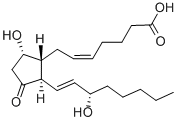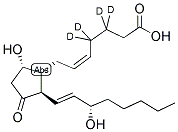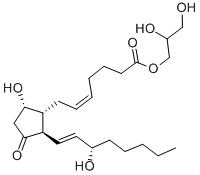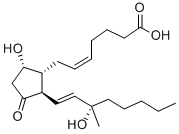≥95%,synthetic , 41598-07-6
Synonym(s):
PGD2;PGDS;prostaglandin D2 synthase (brain);(5Z,9α,13E,15S)-9,15-Dihydroxy-11-oxoprosta-5,13-dien-1-oic-acid;L-PGDS
CAS NO.:41598-07-6
Empirical Formula: C20H32O5
Molecular Weight: 352.47
MDL number: MFCD00077857
EINECS: 636-995-9
| Pack Size | Price | Stock | Quantity |
| 1mg | RMB1747.87 | In Stock |
|
| others | Enquire |
PRODUCT Properties
| Melting point: | 68°C |
| Boiling point: | 406.07°C (rough estimate) |
| alpha | +7.5°(D/21℃)(c=1,THF) |
| Density | 1.0601 (rough estimate) |
| refractive index | 1.6120 (estimate) |
| storage temp. | -20°C |
| solubility | Chloroform (Slightly), Ethanol (Slightly), Methanol (Slightly), THF (Slightly) |
| pka | 4.76±0.10(Predicted) |
| form | White solid |
| color | White to Light Orange |
| biological source | synthetic |
| BRN | 2170623 |
| Stability: | Light Sensitive |
Description and Uses
Prostaglandin D2 (PGD2) is the major eicosanoid product of mast cells and is released in large quantities during allergic and asthmatic anaphylaxis. Mastocytosis patients produce excessive amounts of PGD2, which causes vasodilation, flushing, hypotension, and syncopal episodes. PGD2 is also produced in the brain via an alternative pathway involving a soluble, secreted PGD-
Prostaglandin D2 is a fatty acid compound present in the human body. Elevated levels of localized Prostaglandin D2 has been linked to hair loss and growth inhibition. It has also been seen to contribute to the activity of allergic asthma.
Safety
| Symbol(GHS) |   GHS07,GHS08 |
| Signal word | Danger |
| Hazard statements | H302-H360 |
| Precautionary statements | P201-P301+P312+P330-P308+P313 |
| Hazard Codes | T |
| Risk Statements | 60-22 |
| Safety Statements | 53-22-26-36 |
| WGK Germany | 3 |
| RTECS | UK7930000 |
| F | 10 |





